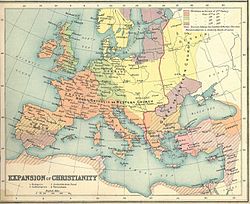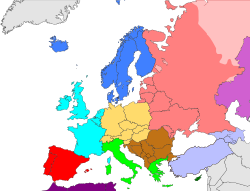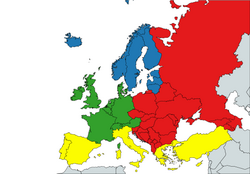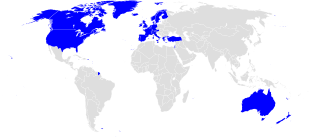Western Europe
|
Read other articles:

Radio station in Charlottesville, Virginia WCHVCharlottesville, VirginiaBroadcast areaCharlottesville, VirginiaAlbemarle County, VirginiaFrequency1260 kHzBrandingC-Ville 107.5 and 1260ProgrammingFormatNews/talk/sportsAffiliationsFox News RadioCompass Media NetworksPremiere NetworksSalem Radio NetworkOwnershipOwnerMonticello Media(Monticello Media, LLC)Sister stationsWCHV-FM, WCYK-FM, WHTE-FM, WHUK, WKAVHistoryFirst air dateOctober 24, 1929 (1929-10-24)Former call signsWEHC (1929�…

Marco Tullio Giordana (kelahiran 1 Oktober 1950 di Milan) adalah seorang sutradara dan penulis latar Italia. Film buatannya Quando sei nato non puoi più nasconderti masuk ke dalam Festival Film Cannes 2005.[1] Filmografi Sutradara To Love the Damned (1980) The Fall of the Rebel Angels (1981) Notti e nebbie (1984) - Film TV Appointment in Liverpool (1988) Especially on Sunday (1991) - segmen La neve sul fuoco L'unico paese al mondo (1994) Who Killed Pasolini? (1995) Scarpette bianche (19…

WDR36 المعرفات الأسماء المستعارة WDR36, GLC1G, TA-WDRP, TAWDRP, UTP21, WD repeat domain 36 معرفات خارجية الوراثة المندلية البشرية عبر الإنترنت 609669 MGI: MGI:1917819 HomoloGene: 6536 GeneCards: 134430 علم الوجود الجيني الوظيفة الجزيئية • RNA binding المكونات الخلوية • نوية• نواة• بلازم نووي• small-subunit processome• Pwp2p-containing subcomplex of 90S pr…

Artikel ini tidak memiliki referensi atau sumber tepercaya sehingga isinya tidak bisa dipastikan. Tolong bantu perbaiki artikel ini dengan menambahkan referensi yang layak. Tulisan tanpa sumber dapat dipertanyakan dan dihapus sewaktu-waktu.Cari sumber: PASIR IPIS – berita · surat kabar · buku · cendekiawan · JSTOR merupakan sebuah bukit yang berada di desa sedong kidul kecamatan sedong kabupaten cirebon diketinggian 800 mdpl pasir ipis terlihat seperti bu…

خانيّة جغتاي 1225 – 1670 خانية جغتايعلم خانية جغتاي بحسب الأطلس الكتالوني خانية جغتاي عام 1300م عاصمة قرشي نظام الحكم غير محدّد نظام الحكم ملكية انتخابية اللغة اللغة المغولية اللغة الجغتائية الديانة شامانية البوذية المسيحية وأخيرا الإسلام السني (صوفية نقشبندية) الحاكم …

Japanese railway company IR Ishikawa RailwayCompany headquartersNative nameIRいしかわ鉄道Company typeThird sectorGenreRail transportFounded28 August 2012HeadquartersKanazawa, Ishikawa, JapanArea servedIshikawa PrefectureServicesPassenger railwayWebsiteishikawa-railway.jp The IR Ishikawa Railway (IRいしかわ鉄道株式会社, IR Ishikawa Tetsudō Kabushiki-gaisha) is a Japanese third-sector railway company established in 2012 to operate passenger railway services on the section of the J…

ملعب فرحات حشادمعلومات عامةسمّي باسم فرحات حشاد المنطقة الإدارية قرقنة البلد تونس الاستعمالالرياضة كرة القدم المستضيف نادي المحيط القرقنيمعلومات أخرىالطاقة الاستيعابية 2,000الموقع الجغرافيالإحداثيات 34°42′N 11°13′E / 34.7°N 11.21°E / 34.7; 11.21 تعديل - تعديل مصدري - تعدي…

شبه جزيرة ريباتشي الإحداثيات 69°42′N 32°36′E / 69.7°N 32.6°E / 69.7; 32.6 تقسيم إداري البلد روسيا[1] التقسيم الأعلى أوبلاست مورمانسك رمز جيونيمز 500038 تعديل مصدري - تعديل شبه جزيرة ريباتشي (بالروسية: полуо́стров Рыба́чий؛ بلغة سامي الشمالية: Giehkirn…

كأس رابطة الأندية الإنجليزية المحترفة 1983–84 تفاصيل الموسم كأس رابطة الأندية الإنجليزية المحترفة النسخة 24º البلد المملكة المتحدة التاريخ بداية:29 أغسطس 1983 نهاية:28 مارس 1984 المنظم دوري كرة القدم الإنجليزية البطل نادي ليفربول عدد المشاركين 92 كأس رابط�…

يفتقر محتوى هذه المقالة إلى الاستشهاد بمصادر. فضلاً، ساهم في تطوير هذه المقالة من خلال إضافة مصادر موثوق بها. أي معلومات غير موثقة يمكن التشكيك بها وإزالتها. (يوليو 2019) منتخب أرمينيا تحت 19 سنة لكرة القدم بلد الرياضة أرمينيا الفئة كرة قدم للرجال تحت 19 سنة [لغات أخرى]̴…

This article includes a list of references, related reading, or external links, but its sources remain unclear because it lacks inline citations. Please help improve this article by introducing more precise citations. (February 2024) (Learn how and when to remove this message) Augustyn Kordecki Abbot Augustyn Kordecki (born Klemens Kordecki Ślepowron coat of arms; November 16, 1603 – March 20, 1673) was a prior of the Jasna Góra Monastery, Poland. He was curate and provincial of the monaster…

Aerial photography by pigeons Pigeon camera redirects here. For the song by the band The Tragically Hip, see Fully Completely. Pigeon with German miniature camera, probably during the First World War Pigeon photography is an aerial photography technique invented in 1907 by the German apothecary Julius Neubronner, who also used pigeons to deliver medications. A homing pigeon was fitted with an aluminium breast harness to which a lightweight time-delayed miniature camera could be attached. Neubron…

Chemical reaction in which two molecules are joined due to a metal catalyst In organic chemistry, a cross-coupling reaction is a reaction where two different fragments are joined. Cross-couplings are a subset of the more general coupling reactions. Often cross-coupling reactions require metal catalysts. One important reaction type is this: R−M + R'−X → R−R' + MX (R, R' = organic fragments, usually aryl; M = main group center such as Li or MgX; X = halide) These reactions are used to form…

Fabless semiconductor company based in San Jose, California This article has multiple issues. Please help improve it or discuss these issues on the talk page. (Learn how and when to remove these template messages) This article's factual accuracy may be compromised due to out-of-date information. Please help update this article to reflect recent events or newly available information. (August 2012) This article relies excessively on references to primary sources. Please improve this article by add…

Japanese entertainment and merchandising franchise This article possibly contains original research. Please improve it by verifying the claims made and adding inline citations. Statements consisting only of original research should be removed. (August 2017) (Learn how and when to remove this message) Super SentaiCreated byShotaro IshinomoriOriginal workHimitsu Sentai GorengerOwnerToei CompanyYears1975–presentFilms and televisionTelevision seriesSee belowGamesTraditionalRangers StrikeVideo game…

Góc thiên đỉnh Mặt Trời là góc giữa các tia song song của Mặt Trời và phương thẳng đứng. Nó là góc phụ với góc cao Mặt Trời, tức là góc chiếu của các tia Mặt Trời so với phương nằm ngang (chân trời), vì thế cosin của góc này là sin của góc kia. Các góc này có thể được tính bằng cùng một công thức, suy ra từ các kết quả của lượng giác cầu.[1][2] Vào thời điểm trưa Mặ…

Franklin HoganLahir(1843-01-07)7 Januari 1843York, PennsylvaniaMeninggal5 April 1932(1932-04-05) (umur 89)Hutchinson, KansasTempat pemakamanHutchinson Eastside Cemetery, Hutchinson, KansasPengabdianAmerika SerikatDinas/cabangAngkatan Darat Amerika SerikatUnion ArmyLama dinas1861 - 1864-->PangkatPrivatKesatuan Company A, 45th Pennsylvania Volunteer Infantry RegimentPerang/pertempuranPerang Saudara AmerikaPenghargaanMedal of Honor Franklin Hogan (26 November 1842 – 29 …

Documento original del último parte. El último parte de la guerra civil española fue firmado por el general Francisco Franco el 1 de abril de 1939 en un folio con el membrete del «Cuartel General del Generalísimo. Estado Mayor». Es un breve texto muy famoso en España; de forma literal, las palabras manuscritas por Franco son las siguientes: En el día de hoy, cautivo y desarmado el Ejército Rojo, han alcanzado las tropas na-cionales sus últimos objeti-vos militares. La guerra ha termina…
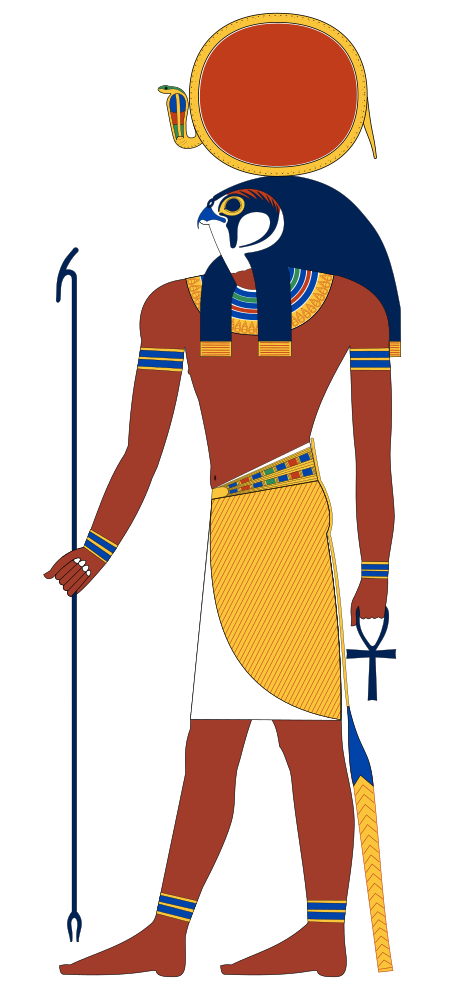
Immagine di Nefertum Nfr-tmin geroglifici Nefertum (o Nefertem) è una divinità egizia appartenente alla religione dell'antico Egitto. Il nome deriva dall'egizio nfr-tm ovvero Perfetto, senza uguali ed era un antico dio della regione di Menfi, la capitale dell'Antico Regno. La Cosmogonia ermopolitana aveva Nefertum tra le divinità principali ma durante il Nuovo Regno il dio Ptah venne dotato di una famiglia. Secondo la leggenda, Nefertum divenne figlio del dio Ptah e della dea Sekhmet ma a Eli…

Spanish heavy vehicle manufacturer URO, Vehículos Especiales, S.A.Company typeSociedad AnónimaIndustryAutomotiveFounded23 October 1981; 42 years ago (1981-10-23)HeadquartersSantiago de Compostela, Galicia, SpainProductsVAMTAC, UROSubsidiariesUROMACWebsitewww.urovesa.com URO, Vehículos Especiales, S.A. (UROVESA) is a Spanish heavy vehicle manufacturer based in Santiago de Compostela, Galicia. It is best known for the production of the URO VAMTAC, a Humvee-like four-wheel driv…
